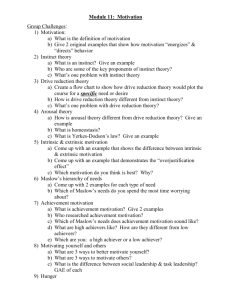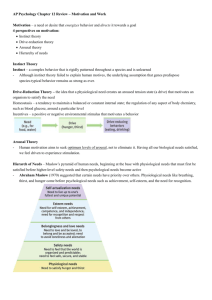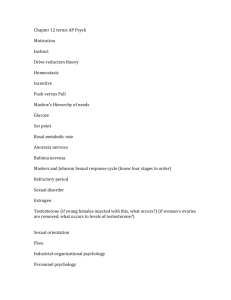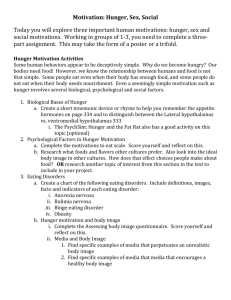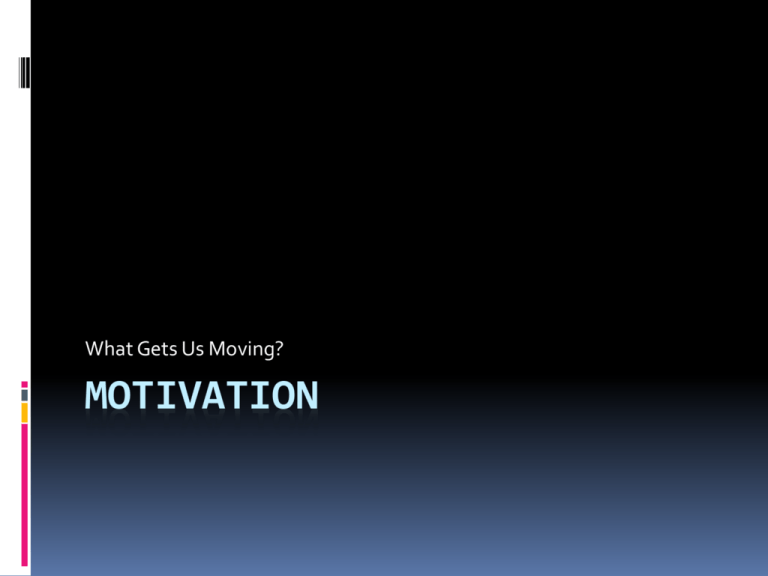
What Gets Us Moving?
MOTIVATION
Motivation
Motivation: a need or desire that energizes
and directs behavior
Motivational Concepts
Instinct Theory (Evolutionary Theory)
Drive-Reduction Theory
Arousal Theory
Maslow’s Hierarchy of Needs
Motivational Concepts
Instinct/Evolutionary
Influenced by Darwin
Instinct: complex behavior that is rigidly
patterned throughout a species and is
unlearned
Ex. Infants reflexes
Issues: Theory fails to explain human motives
However, still explains underlying assumption that
genes predispose species typical behavior
Motivational Concepts
Drive Reduction Theory:
Replaced Instinct Theory
Idea that physiological needs creates an aroused
tension state (a drive) that motivates an organism
to satisfy the need
As physical need increases, psychological drive also
increases
Incentives: positive or negative environmental
stimulus that motivates behavior
When there is a need and incentive we feel strongly
driven
Aim for each person is homeostasis: tendency to
maintain a balanced or constant internal state
Motivational Concepts
Optimal Arousal Theory
We seek optimum levels of excitement:
Without such stimulation, we get bored.
Examples:
Climbing a mountain
Taking AP Psychology
Maintaining a high GPA
Bringing in thousands of cans in order to beat Mrs.
Faulkner’s class!
Motivational Concepts
Maslow’s Hierarchy of Needs
Maslow’s pyramid of human needs.
Beginning at the base with physiological
needs that must first be satisfied before
moving up the pyramid to higher levels
(You will draw/label the pyramid later)
Maslow’s Hierarchy
Turn to page 331- draw Maslow’s Hierarchy of
Needs and level each section.
Next, reflect on your activities over the past
month. Enter three significant behaviors that
you think demonstrate the operation of a
need at each level of Maslow’s hierarchy.
Please indicate the degree to which you are
satisfied that your need has been met at each
level. Use a scale of 1 (totally unsatisfied) to 6
(totally satisfied).
HUNGER & MOTIVATION
David Mandel, a Nazi concentration camp
survivor, recalled how a starving “father and
son would fight over a piece of bread. Like
dogs.” One father, whose 20 year old son stole
his bread from under his pillow while he slept,
went into a deep depression, asking over and
over how his son could do such a thing. The
next day the father died. “Hunger does
something to you that’s hard to describe.”
Hunger and Motivation
WWII concentration camps demonstrated the
supremacy of physiological needs
Ancel Keys experiment on semistarvation
36 Male Volunteers
6 months food level cut in half
Beginning of energy conservation
Weight dropped rapidly and stabilized @ 25% below
initial weight
Activated motives hijack out consciousness
Body Chemistry and the Brain
People automatically regulate their caloric
intake to prevent energy deficits
Glucose: form of sugar that circulates in the blood
and provides the major source of energy for body
tissue.
When it is low, we feel hungry
Body Chemistry and the Brain
Hypothalamus: Hunger controls
Lateral hypothalamus (located on
the sides): brings on hunger
Tells the body to release orexin
which is a hunger triggering hormone
Ventromedial hypothalamus:
depresses hunger and is located in the
lower-mid section of the
hypothalamus
Body Chemistry and the Brain
Set point:
When a body falls below individual’s “weight
thermostat”, an increase in hunger and a
lowered metabolic rate may act to restore the
lost weight
Psychology of Hunger
Physical hunger is often paired with
psychological hunger
Taste preferences
Feeling depressed you eat food that boosts the level
of serotonin
Carbs
Preferences for salty and sweet are typically
universal
Culture affects taste (neophobia: the dislike of
things unfamiliar)
Eating Disorders
Anorexia: eating disorder in which a person
diets and becomes significantly underweight,
yet, still feeling fat, continue to starve
themselves
.6% of the population (18.2 million)
75% are female
50% display binge-purge-depression cycle
Eating Disorders
Bulimia nervosa: eating disorder
characterized by episodes of over eating,
usually of high-calorie foods, followed by
vomiting, laxative use, fasting, or excessive
exercise
Eating Disorders
Binge-eating disorder: significant binge-
eating episodes followed by distress, disgust,
or guilt, but without purging, fasting, or
excessive exercise that marks bulimia
2.8% of the population at some time in their lives
meet the criteria for this
Eating Disorders
Three family environmental aspects
Mothers of girls with eating disorders tend to
focus on their own weight and on their daughters
weight and appearance
Families of bulimia patients have a higher-thanusual incidence of childhood obesity and negative
self-evaluation
Families of anorexia patients tend to be
competitive, high-achieving, and protective
Does our society pressure girls to be thin?
Obesity and Weight Control
Obesity
35.7% of American adults are obese
17% of American children are obese
Kentucky is ranked 7th in the leading obese states.
Is fighting fat a social responsibility?
A government responsibility?
Mini-FRQ action
Bob is on his way home from work. He has
not eaten all day, but has expended a lot of
effort on the line at Toyota. Apply the
following terms to Bob’s scenario:
Glucose
Set Point
Hierarchy of needs
SEXUAL MOTIVATION
Sexual Motivation
What stages mark the human sexual
response cycle?
Masters and Johnson describe four stages in
the human sexual response cycle:
Excitement
Plateau
Orgasm (males and females respond
similarly both emotionally and
neurologically)
Resolution
Sexual Motivation
During the resolution stage males experience
the refractory period in which renewed arousal
and orgasm are impossible
Sexual disorders can be successfully
treated, often by behaviorally oriented
therapy or drug therapy
Sexual Motivation
Hormones:
Females= estrogen
Males= testosterone
However, women’s sexuality is more
responsive to testosterone level than
estrogen levels
Research shows that women fantasize about
sex or wear more sexually attractive clothing
around ovulation
Sexual Motivation
Short-term hormonal changes have little
effect on desire
Large shifts that occur due to the aging
process have a much greater effect
As sex hormones decline with age, frequency
of sexual fantasies reduce and the desire for
intercourse also declines
Sexual Motivation
Psychology of Sex
Studies confirm that men become aroused
when examining erotic material
However, studies also report that women
exhibit nearly as much arousal as men do to
same material
Sexually explicit material can have adverse
effect
Imagined Stimuli
95% of both males and females say they
have had sexual fantasies
Sexual Motivation
Adolescent Sexuality
1900- 3% of American women had
experienced premature sex by age 18
1991- 54%
2005- 47% of teens had experienced
premature sex
Teen Pregnancy
American teens have a lower rate of
contraceptive use and thus higher rate of
pregnancy.
WHY?
Sexual Motivation
Ignorance
Minimal communication about birth control
Guilt related to sexual activity
Alcohol use
Mass media
Predictors of sexual restraint
High intelligence
Religious engagement
Father presence
Participation in service learning programs
Sexual Motivation
Sexual Orientation and Research:
2.5% of U.S. population is gay or lesbian
Sexual orientation is neither willfully
chosen nor willfully changed.
Much like handedness:
Most people are one way, some the other. A
very few are truly ambidextrous.
Some degree of homosexuality seems to be a
natural part of the animal world.
LeVay study
Found that one hypothalamic cell cluster is larger in
straight men than in women & gay men.
Hypothalamus not sexual orientation center but
important in conducting neural pathways for sexual
behavior.
Gay men & straight women have brain
hemispheres of similar size
Lesbian women & straight men have a larger
right hemisphere
Genes & Sexual Orientation
No statistical evidence that environmental influences
determine sexual orientation
Homosexuality appears to run in families
Abnormal prenatal hormone conditions between the
2nd & 5th month of development have been a topic of
research.
A lesbian’s cochlea and hearing systems develop in a
different way compared to heterosexual males &
females
Heterosexual females & gay men
have less fingertip ridges on their
right hand.
Final word- sexual orientation
is biological and not a lifestyle
choice!
Need to Belong
Belong: to feel connected and identified with
others
Survival value to our ancestors
Could explain why humans live in groups in every
society
Societies control behavior with threat of ostracism
When socially excluded people may engage in selfdefeating behaviors
Motivation to Work
Why do we work?
Reasons vary person to person
Many will declare happiness or money as primary
reasons for working
Motivation to Work
Personal psychologist work with
organizations to devise selection methods of
new employees, recruit, and evaluate
applicants



